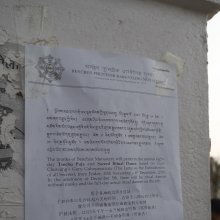Vajramandala, Vajramaṇḍala, Vajra-mandala: 3 definitions
Introduction:
Vajramandala means something in Buddhism, Pali, Hinduism, Sanskrit. If you want to know the exact meaning, history, etymology or English translation of this term then check out the descriptions on this page. Add your comment or reference to a book if you want to contribute to this summary article.
Images (photo gallery)
In Buddhism
Mahayana (major branch of Buddhism)
Source: academia.edu: A Study and Translation of the GaganagañjaparipṛcchāVajramaṇḍala (वज्रमण्डल) refers to the “circle of diamond”, according to the Gaganagañjaparipṛcchā: the eighth chapter of the Mahāsaṃnipāta (a collection of Mahāyāna Buddhist Sūtras).—Accordingly, as Bodhisattva Gaganagañja explains to Bodhisattva Ratnaśrī what kind of concentration should be purified: “[...] (28) [when the Bodhisattvas attain] the concentration called ‘Being endowed with a core’, all promises will be carried out; (29) [when the Bodhisattvas attain] the concentration called ‘Circle of diamond’ (vajramaṇḍala-samādhi), supernormal knowledges will be never given up; (30) [when the Bodhisattvas attain] the concentration called ‘Vajra-essence’, they will go to the essence of awakening; [...]”.

Mahayana (महायान, mahāyāna) is a major branch of Buddhism focusing on the path of a Bodhisattva (spiritual aspirants/ enlightened beings). Extant literature is vast and primarely composed in the Sanskrit language. There are many sūtras of which some of the earliest are the various Prajñāpāramitā sūtras.
Tibetan Buddhism (Vajrayana or tantric Buddhism)
Source: OSU Press: Cakrasamvara SamadhiVajramaṇḍala (वज्रमण्डल) refers to the “Vajra Mandala”, according to the Guru Mandala Worship (maṇḍalārcana) ritual often performed in combination with the Cakrasaṃvara Samādhi, which refers to the primary pūjā and sādhanā practice of Newah Mahāyāna-Vajrayāna Buddhists in Nepal.—Accordingly, “Oṃ you have done the aim of all beings, granting the success that follows, Go away, to disperse in the Buddha sphere and return again! Oṃ Āḥ Hūṃ dismissal of the Vajramaṇḍala Mūḥ”.

Tibetan Buddhism includes schools such as Nyingma, Kadampa, Kagyu and Gelug. Their primary canon of literature is divided in two broad categories: The Kangyur, which consists of Buddha’s words, and the Tengyur, which includes commentaries from various sources. Esotericism and tantra techniques (vajrayāna) are collected indepently.
Languages of India and abroad
Sanskrit dictionary
Source: Cologne Digital Sanskrit Dictionaries: Edgerton Buddhist Hybrid Sanskrit DictionaryVajramaṇḍala (वज्रमण्डल).—m., name of a samādhi: Mahāvyutpatti 529; Śatasāhasrikā-prajñāpāramitā 1417.8.
Sanskrit, also spelled संस्कृतम् (saṃskṛtam), is an ancient language of India commonly seen as the grandmother of the Indo-European language family (even English!). Closely allied with Prakrit and Pali, Sanskrit is more exhaustive in both grammar and terms and has the most extensive collection of literature in the world, greatly surpassing its sister-languages Greek and Latin.
See also (Relevant definitions)
Partial matches: Vajra, Mandala.
Starts with: Vajramandalasamadhi.
Full-text: Punaragamana, Agamana, Buddhavishaya, Visarjana, Mandala.
Relevant text
Search found 2 books and stories containing Vajramandala, Vajramaṇḍala, Vajra-mandala, Vajra-maṇḍala; (plurals include: Vajramandalas, Vajramaṇḍalas, mandalas, maṇḍalas). You can also click to the full overview containing English textual excerpts. Below are direct links for the most relevant articles:
The Agni Purana (by N. Gangadharan)
Maha Prajnaparamita Sastra (by Gelongma Karma Migme Chödrön)
Part 5-6 - Description of sarvākāra (all aspects) and sarvadharma (all dharmas) < [Chapter XVI - The Story of Śāriputra]
